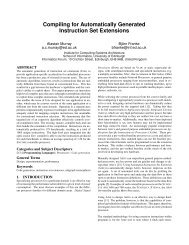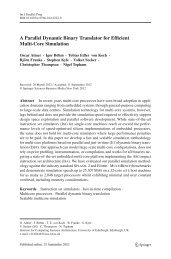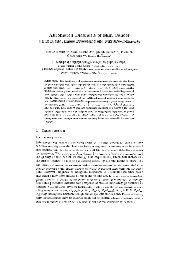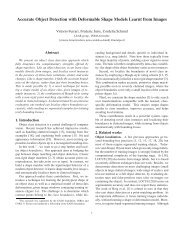Estimation of surface normals for use in 3D rendering ... - IEEE Xplore
Estimation of surface normals for use in 3D rendering ... - IEEE Xplore
Estimation of surface normals for use in 3D rendering ... - IEEE Xplore
Create successful ePaper yourself
Turn your PDF publications into a flip-book with our unique Google optimized e-Paper software.
ESTIMATION OF SURFACE NORMALS FOR USE IN <strong>3D</strong> RENDERING OF<br />
MEDICAL IMAGES<br />
Xiaop<strong>in</strong>g D<strong>in</strong>g', Karen All. Mudryl, Christopher H. Wood2<br />
'Department <strong>of</strong> Biomedical Eng<strong>in</strong>eer<strong>in</strong>g, The University <strong>of</strong> Akron, Akron OH 44325<br />
2Ficker Intemational, 595 M<strong>in</strong>or Road, Highland Hts., OH 44143<br />
&.tract - Three dimensional (<strong>3D</strong>) <strong>surface</strong><br />
render<strong>in</strong>g techniques have been applied to<br />
various medical images <strong>in</strong> recent yeazs.<br />
The quality <strong>of</strong> the rendered image 1.5<br />
dependent on the estimation <strong>of</strong> the<br />
<strong>surface</strong> normal. A new method <strong>for</strong><br />
estimat<strong>in</strong>g the <strong>surface</strong> normal, called the<br />
modified eigenvector method, is<br />
described. The modified eigenvector<br />
method was developed <strong>in</strong> order to overcome<br />
some <strong>of</strong> the shortcom<strong>in</strong>gs <strong>of</strong> other<br />
methods. The modified eigenvector method<br />
is compared quantitatively us<strong>in</strong>g<br />
simulated data and qualitatively us<strong>in</strong>g<br />
human CT data to the gray-level gradient<br />
method and the eigenvector method <strong>of</strong><br />
<strong>surface</strong> normal estimation.<br />
RFTRODUCTIOH<br />
Medical imag<strong>in</strong>g devices, such as CT<br />
and MR, generate a series <strong>of</strong> 2D slices.<br />
The analysis <strong>of</strong> these images is usually<br />
through the sequential observation <strong>of</strong> the<br />
slices and mental reconstruction <strong>of</strong> the<br />
object <strong>of</strong> <strong>in</strong>terest by the <strong>in</strong>terpret<strong>in</strong>g<br />
physician. With many imag<strong>in</strong>g systems it<br />
is possible to generate a 2D projection<br />
<strong>of</strong> a <strong>3D</strong> image through <strong>surface</strong> render<strong>in</strong>g.<br />
The object <strong>of</strong> <strong>in</strong>terest must first be<br />
segmented from the image and then the<br />
gray scale <strong>of</strong> the displayed <strong>surface</strong><br />
pixels must be determ<strong>in</strong>ed <strong>in</strong> order to<br />
generate the illusion <strong>of</strong> the <strong>3D</strong> object.<br />
The most cormnon methods to locate the<br />
<strong>surface</strong> <strong>of</strong> the object <strong>of</strong> <strong>in</strong>terest are<br />
gtay-scale threshold, gray-scale<br />
gradient, and zero-cross<strong>in</strong>g <strong>of</strong> the second<br />
derivative (11. For the gray-scale<br />
threshold method, the <strong>surface</strong> po<strong>in</strong>ts that<br />
will be displayed correspond to pixels<br />
with the same gray scale value or a gray<br />
scale value larger than the threshold <strong>in</strong><br />
the orig<strong>in</strong>al data. A shad<strong>in</strong>g function is<br />
then <strong>use</strong>d to determ<strong>in</strong>e the displayed<br />
shade <strong>of</strong> these <strong>surface</strong> po<strong>in</strong>ts so that the<br />
illusion <strong>of</strong> a <strong>3D</strong> object is generated.<br />
The most <strong>of</strong>ten <strong>use</strong>d shad<strong>in</strong>g function was<br />
proposed by Phong [21, a commonly <strong>use</strong>d<br />
version <strong>of</strong> which is:<br />
[l] where I is the <strong>in</strong>tensity <strong>of</strong> the<br />
<strong>surface</strong> po<strong>in</strong>t, Ib is the ambient light<br />
<strong>in</strong>tensity, Rb is the reflectivity <strong>of</strong> the<br />
ambient light, Id is the <strong>in</strong>tensity <strong>of</strong> a<br />
po<strong>in</strong>t source <strong>of</strong> light, Rd is the diff<strong>use</strong><br />
reflectivity coefficient <strong>of</strong> the <strong>surface</strong>,<br />
and R, is the specular reflectivity<br />
coefficient. The view<strong>in</strong>g distance is r,<br />
and k is a constant. The 8 is the angle<br />
between the direction <strong>of</strong> the po<strong>in</strong>t light<br />
source and the <strong>surface</strong> normal. The angle<br />
between the direction <strong>of</strong> the reflected<br />
light and the view<strong>in</strong>g direction is a. If<br />
only the diff<strong>use</strong> reflectivity is<br />
considered, the first term and the last<br />
term <strong>in</strong> the above equation become zero.<br />
If the viewer is at the same po<strong>in</strong>t as the<br />
light source and the light source is at<br />
<strong>in</strong>f<strong>in</strong>ity, the equation is simplified to I<br />
= constant cos 6 . This result implies<br />
that the projection <strong>of</strong> the <strong>surface</strong> normal<br />
on the view<strong>in</strong>g direction is proportional<br />
to the shade <strong>of</strong> a pixel on the rendered<br />
<strong>surface</strong>. S<strong>in</strong>ce this value is determ<strong>in</strong>ed<br />
from the dot product <strong>of</strong> the unit <strong>surface</strong><br />
nom1 vector with the view<strong>in</strong>g direction<br />
vector, the importance <strong>of</strong> know<strong>in</strong>g the<br />
<strong>surface</strong> normal is critical.<br />
A number <strong>of</strong> methods have been <strong>use</strong>d<br />
to f<strong>in</strong>d the <strong>surface</strong> normal, among which<br />
are the gray-scale gradient method, the<br />
adaptive gray-scale gradient method, the<br />
depth-gradient method 131 and the<br />
eigenvector method 141. The eigenvector<br />
method was developed to attempt to<br />
overcome some <strong>of</strong> the shortcom<strong>in</strong>gs <strong>of</strong> the<br />
gradient methods; e.g., th<strong>in</strong> <strong>surface</strong>s and<br />
noisy images. The modified eigenvector<br />
method, described below, was developed to<br />
attempt to overcome the dependence on the<br />
coord<strong>in</strong>ate system found with the<br />
eigenvector method.<br />
I42
METHODS<br />
This study compared the gray-level<br />
gradient, the eigenvector and the<br />
modified eigenvector methods <strong>for</strong><br />
determ<strong>in</strong><strong>in</strong>g the <strong>surface</strong> <strong>normals</strong> and hence<br />
the <strong>surface</strong> rendered images.<br />
For the gray-level gradient method two<br />
adjacent pixels <strong>for</strong> each axis were <strong>use</strong>d<br />
<strong>in</strong> the calculation; the normal be<strong>in</strong>g<br />
N = (dx, dy, dz)<br />
where dx, dy, dz are the central<br />
differences and N is normalized to a unit<br />
vector.<br />
For the eigenvector method either 2, 4,<br />
or 6 neighbors <strong>in</strong> each axis direction and<br />
the gray scale values <strong>of</strong> these pixels<br />
were <strong>use</strong>d. The <strong>surface</strong> normal is<br />
N = V1 = (XI, yl, 21) '<br />
where V1 is the normalized eigenvector<br />
associated with the largest eigenvalue,<br />
11, <strong>of</strong> the covariance matrix A.<br />
For the modified eigenvector method all<br />
<strong>of</strong> the pixel above a threshold <strong>in</strong> a cubic<br />
neighborhood <strong>of</strong> the pixel under<br />
consideration and the re 1 at i ve<br />
coord<strong>in</strong>ates <strong>of</strong> these pixels, rather than<br />
their gray scale values, are <strong>use</strong>d to f<strong>in</strong>d<br />
the normal. The normal is<br />
N = V3 = (xl, yl, zl)<br />
where V3 is the normalized eigenvector<br />
associated with the smallest eigenvalue,<br />
h, <strong>of</strong> the covariance matrix A.<br />
The above three methods to compute<br />
the <strong>surface</strong> normal were evaluated on data<br />
sets conta<strong>in</strong><strong>in</strong>g a spherical object. Two<br />
<strong>of</strong> the data sets had a step transition<br />
between the object and the background,<br />
one with noise and one without. The<br />
other two sets had a l<strong>in</strong>ear transition<br />
between the object and the background,<br />
one with noise and one without. The<br />
techniques also were tested on human CT<br />
data acquired us<strong>in</strong>g a Picker<br />
International, Inc. CT scanner.<br />
RESULTS<br />
Both the eigenvector method and the<br />
modified eigenvector method produced<br />
images with comparable quality to the<br />
gray-level gradient method. The<br />
quantitative studies showed that the<br />
eigenvector method was more accurate than<br />
the gray-level gradient method when 4 or<br />
6 neighbors were <strong>use</strong>d <strong>in</strong> the calculation<br />
and that the modified eigenvector method<br />
was more accurate than the gray-level<br />
gradient method and the eigenvector<br />
method <strong>for</strong> the step transition between<br />
the object and the background. The<br />
eigenvector method was more accurate than<br />
the modified eigenvector method when the<br />
transition between the object' and the<br />
background was l<strong>in</strong>ear. For both the<br />
eigenvector method and the modified<br />
eigenvector method calculations us<strong>in</strong>g 4<br />
neighbors were more accurate than us<strong>in</strong>g 2<br />
neighbors.<br />
The studies us<strong>in</strong>g human CT data<br />
showed that the eigenvector method<br />
revealed some f<strong>in</strong>e structures that could<br />
not be seen us<strong>in</strong>g the gray-level gradient<br />
method; however, this method tended to<br />
exaggerate the small structures. The<br />
modified eigenvector method produced<br />
images that looked smooth, but flat.<br />
Both the eigenvector method and the<br />
modified eigenvector method were<br />
computationally more expensive than the<br />
gray-level gradient method.<br />
REFERENCES<br />
[lIM. Magnusson, R. Lenz, P.E. Danielsson<br />
(1988). Evaluation <strong>of</strong> Methods <strong>for</strong> Shaded<br />
Surface Display <strong>of</strong> CT-Volumes.<br />
Proceed<strong>in</strong>gs <strong>of</strong> the 9th ICPR, 1287-1294.<br />
121 B.T. Phong (1975) . Illum<strong>in</strong>ation <strong>for</strong><br />
Computer Generated Pictures.<br />
Communications <strong>of</strong> the ACM, 18(6) :311-317.<br />
[SlU. Tiede, K.H. Hoehne, M. Bomas, A.<br />
Pommert, M. Riemer, G. Wiebeck (1990).<br />
Investigation <strong>of</strong> Medical <strong>3D</strong>-Render<strong>in</strong>g<br />
Algorithms. <strong>IEEE</strong> Computer Graphics and<br />
Applications, 10:41-53.<br />
[4]C.H. Wood, X. D<strong>in</strong>g, W. Satt<strong>in</strong> (1991).<br />
Eigenvector Surface Normal <strong>Estimation</strong> <strong>in</strong><br />
Medical Imag<strong>in</strong>g. 9th Annual Meet<strong>in</strong>g <strong>of</strong><br />
the Society <strong>for</strong> Magnetic Resonance<br />
Imag<strong>in</strong>g, Chicago, IL.









